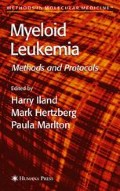Summary
With the development of fluorescence in situ hybridization (FISH), it was possible to detect the BCR-ABL fusion signal in both metaphase spreads and interphase cells of patients with chronic myeloid leukemia (CML). However, the use of FISH to detect residual disease in patients with CML post therapy was limited by the false positive rate using the early single fusion probes. Therefore, dual fusion probes that created a fusion signal on the derivative chromosome 9 in addition to the fusion sifnal on the Philadelphia chromosome or derivative chromo-some 22 were developed. Using these second-generation probes, it was discovered that a significant proportion of CML cases has a sub-microscopic deletion at the site of the ABL-BCR fusion. This chapter outlines a testing strategy to identify deleltions of the derivative chromo-some 9 and to use combinations of probes to identify residual disease in these cases.
Access this chapter
Tax calculation will be finalised at checkout
Purchases are for personal use only
References
Goldman J. M. and Melo J. V. (2003) Chronic myeloid leukemia-advances in biology and new approaches to treatment. N. Engl. J. Med. 349, 1451–1464.
Chase A., Grand F., Zhang J. G., Blackett N., Goldman J., and Gordon M. (1997) Factors influencing the false positive and negative rates of BCR-ABL fluorescence in situ hybridization. Genes Chrom Cancer 18, 246–253.
Dewald G. W., Wyatt W. A., Juneau A. L., et al. (1998) Highly sensitive fluorescence in situ hybridization method to detect double BCR/ABL fusion and monitor response to therapy in chronic myeloid leukemia. Blood 91, 3357–3365.
Sinclair P. B., Nacheva E. P., Leversha M., et al. (2000) Large deletions at the t(9;22) breakpoint are common and may identify a poor-prognosis subgroup of patients with chronic myeloid leukemia. Blood 95, 738–744.
Herens C., Tassin F., Lemaire V., et al. (2000) Deletion of the 5′-ABL region: a recurrent anomaly detected by fluorescence in situ hybridization in about 10% of Philadelphia-positive chronic myeloid leukemia patients. Br. J. Haematol. 110, 214–216.
Huntly B. J. P., Reid A. G., Bench A. J., et al. (2001) Deletions of the derivative chromosome 9 occur at the time of the Philadelphia translocation and provide a powerful and independent prognostic indicator in chronic myeloid leukemia. Blood 98, 1732–1738.
Kolomietz E., Al-Maghrabi J., Brennan S., et al. (2001) Primary chromosomal rearrangements of leukemia are frequently accompanied by extensive submicro-scopic deletions and may lead to altered prognosis. Blood 97, 3581–3588.
de la Fuente J., Merx K., Steer E. J., et al. (2001) ABL-BCR expression does not correlate with deletions on the derivative chromosome 9 or survival in chronic myeloid leukemia. Blood 98, 2879–2880.
Huntly B. J. P., Bench A. J., Delabesse E., et al. (2002) Derivative chromosome 9 deletions in chronic myeloid leukemia: poor prognosis is not associated with loss of ABL-BCR expression, elevated BCR-ABL levels, or karyotypic instability. Blood 99, 4547–53.
Anelli L., Albano F., Zagaria A., et al. (2004) A chronic myelocytic leukemia case bearing deletions on the three chromosomes involved in a variant t(9;22;11). Cancer Genet. Cytogenet. 148, 137–140.
Huntly B. J. P., Guilhot F., Reid A. G., et al. (2003) Imatinib improves but may not fully reverse the poor prognosis of patients with CML with derivative chro-mosome 9 deletions. Blood 102, 2205–2212.
Smoley S. A., Brockman S. R., Paternoster S. F., Meyer R. G., and Dewald G. W. (2004) A novel tricolor dual-fusion fluorescence in situ hybridisation method to detect BCR/ABL fusion in cells with t(9;22)(q34;q11.2) associated with deletion of DNA on the derivative chromosome 9 in chronic myelocytic leukemia. Cancer Genet. Cytogenet. 148, 1–6.
Mitelman F. (ed) (1995) An International System for Human Cytogenetic Nomenclature. S. Karger, Basel.
Editor information
Editors and Affiliations
Rights and permissions
Copyright information
© 2006 Humana Press Inc.
About this protocol
Cite this protocol
Campbell, L.J. (2006). Deletion of the Derivative Chromosome 9 in Chronic Myeloid Leukemia. In: Iland, H., Hertzberg, M., Marlton, P. (eds) Myeloid Leukemia. Methods In Molecular Medicine™, vol 125. Humana Press. https://doi.org/10.1385/1-59745-017-0:107
Download citation
DOI: https://doi.org/10.1385/1-59745-017-0:107
Publisher Name: Humana Press
Print ISBN: 978-1-58829-485-2
Online ISBN: 978-1-59745-017-1
eBook Packages: Springer Protocols

